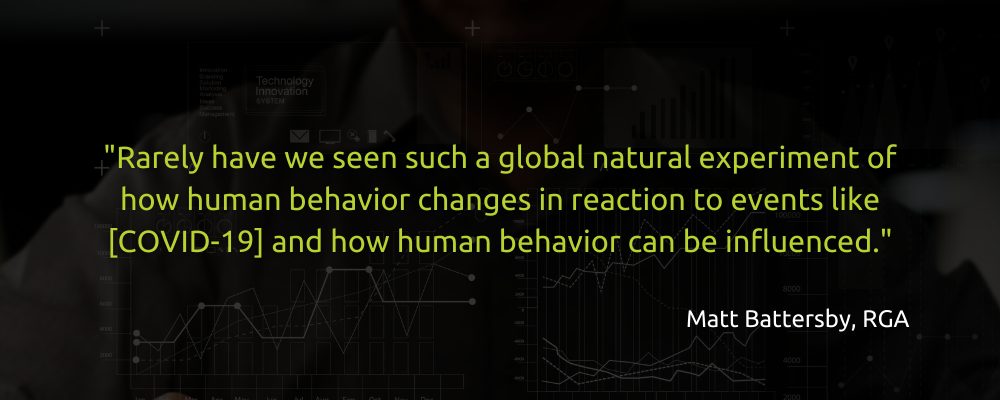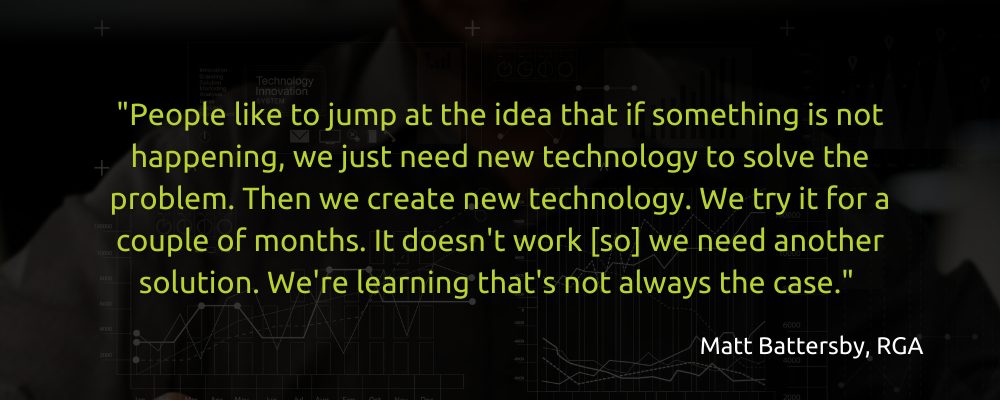Selling Life Insurance: Four Lessons Learned from the Pandemic
There’s a well-known adage in our industry: Life insurance is sold, not bought. Of course, the science of selling – anything, not just life insurance – requires an understanding of why people do what they do. The more you grasp your buyers’ motivations, the shorter the sales cycle, the higher the conversion rate, and the happier your customers are.
For this Future of Healthcare Roundtable series, we invited two panelists with deep expertise in applying behavioral science to life insurance to explore changing behaviors at scale:
Emma Jones, Executive Director, Underwriting Innovation and Strategic Development, RGAX EMEA
Matt Battersby, Chief Behavioral Scientist, RGA
As usual, our Future of Healthcare Roundtable was moderated by James Somauroo, the founder of SomX.
Click to listen to Future of Healthcare Roundtable: Changing Behaviors at Scale
Emma, Matt, and James discuss the COVID-19 pandemic, what it taught us about human behavior, and how these learnings can be applied to selling life insurance. In this post, I’ll share some highlights from the session and some additional insights from my perspective as the Commercial Director of RGAX EMEA.
Applying Behavioral Science to Life Insurance Sales
To kick off the roundtable, Matt laid out three ways behavioral science can be applied to life insurance sales.
First, buying life insurance goes against our natural human motivations for buying a product or service. Life insurance is a long-term investment for most people and one they aren’t around to enjoy. While sellers of other products can apply basic motivators such as status, comfort, convenience, and so on, life insurance sellers need to dig deeper to uncover the real reasons people buy our products.
Second, the trust factor in life insurance sales is flipped on its head. When selling other products, the level of trust the buyer has in the seller is a primary factor. That’s still a prerequisite for life insurance since the buyer needs to know they’ll get what they paid for. However, life insurance sales also require the seller to trust that the customer is honest and accurate when filling out an application.
Third, in life insurance sales, the seller’s cost model is influenced by the buyer’s future behavior. Behavioral science can help carriers determine why people engage in certain behaviors throughout their lifetimes and help them trigger more positive behaviors than negative ones.
Lessons Learned from COVID-19
The COVID-19 pandemic taught us a lot about human behavior and what motivates people. Some scenarios confirmed what we already knew, but others changed our understanding of why people do what they do. Here are a few of the learnings discussed at the roundtable.

Lesson #1: Expect an emotional response to risk.
COVID-19 increased everyone’s awareness of their mortality, which was reflected in life insurance sales. According to the MIB Life Index, life insurance application activity in the US rose by four percent in 2020, more than any other year on record. However, if buying behaviors were entirely fact-based, we might expect the largest jumps in sales to come from the most vulnerable groups: older people and those with preexisting conditions.
As Matt reported in an article published by the Society of Actuaries, that’s not what happened. The growth in demand for life insurance products in the US was greatest among younger age groups: a 7.9 percent rise among those aged forty-four and under and a 3.8 percent rise among those aged forty-five to fifty-nine. Demand from those aged sixty and older actually dropped by 1.7 percent.
People do not always seek information to make more accurate, fact-based decisions. Many actively avoid useful information if it evokes painful emotions, and instead seek comfort. This is the reason many people weigh themselves less frequently when they fear weight gain or check their bank balances less often as they get into debt: some information is useful but provokes emotions people want to avoid. Similarly, most people do not instinctively seek out information about health risks or life insurance.1

Lesson #2: New tech isn’t always the answer.
Another interesting point that came up during the roundtable was that new technology isn’t always the answer.
COVID-19 gave us an excellent example of how providers can make care more accessible using older technologies. According to NHS data, telehealth services spiked in England during the pandemic, but face-to-face visits weren’t necessarily being replaced with Zoom calls between patient and provider. The big winner was the telephone. In fact, video and online visits fell by almost half while telephone consults nearly tripled.
At RGAX, we’re always searching for ways technology can help accelerate underwriting, but sometimes it’s the process itself that needs to be streamlined. As Emma points out in the discussion, we need to make the process of shopping for life insurance easy and accessible. That means adapting to what is happening across the globe, reacting to changes, and reflecting the consumer’s expectations in the digital underwriting journey.

Lesson #3: Don’t assume you know the why.
As we recorded the roundtable, the pressure was on to get as many people vaccinated as quickly as possible. Matt brought up a good point: you can’t assume that those who aren’t getting the vaccine are anti-vaxxers. There are far too many variables involved to boil it down to just one.
Emma and Matt had an excellent back-and-forth discussion on the problems with making assumptions during the underwriting process. It’s no secret that people aren’t always truthful about their disclosures. However, we shouldn’t assume they are lying to save money. They may not remember the details, or they may not have understood what was being asked. Emma had a few interesting suggestions for how to overcome these challenges that are definitely worth listening to.
Lesson #4: The carrot and the stick work.
Just as we don’t always know why someone doesn’t behave the way we want them to, we don’t always know what motivates them to act differently. To increase vaccination levels, various countries and political subsections have tried both the carrot (e.g., free beer and lotteries) and the stick (e.g., vaccine passports). Their efforts have been met with varying degrees of success.
This is good food for thought as we look at how carriers can encourage healthy behaviors after the sale. There is a vast array of tech and non-tech solutions being tried right now (e.g., wellness programs, discounts, badges, and gamification), but there is no one approach that will motivate every customer.
No one-size-fits-all answer
As Matt pointed out, behavioral science has been saying for a long time that there is no one-size-fits-all answer to why people do what they do. While COVID-19 had us plugging people into physical groups by age, comorbidity, and so forth, the irony is that the pandemic showed just how hard it is to sort people by demographic profiles. Throughout the COVID-19 crisis, any attempt to do so has been reductionistic at best and often counterproductive.
The parallel to the life insurance business is unmistakable. Underwriting is driven by tables that calculate an individual’s mortality risk by mostly physical characteristics such as age, gender, weight, and medical conditions. Yet selling life insurance and getting people to take better care of themselves is almost entirely driven by the emotional and psychological makeup of individuals. We need to respect individuality while studying why people do what they do and then incorporate those learnings into a personalized journey for the life insurance buyer.
Listen to Future of Healthcare Roundtable Series: Changing Behaviors at Scale >>
1 Risk Perception and Life Insurance Sales: Lessons From COVID-19, Society of Actuaries, May 2021

